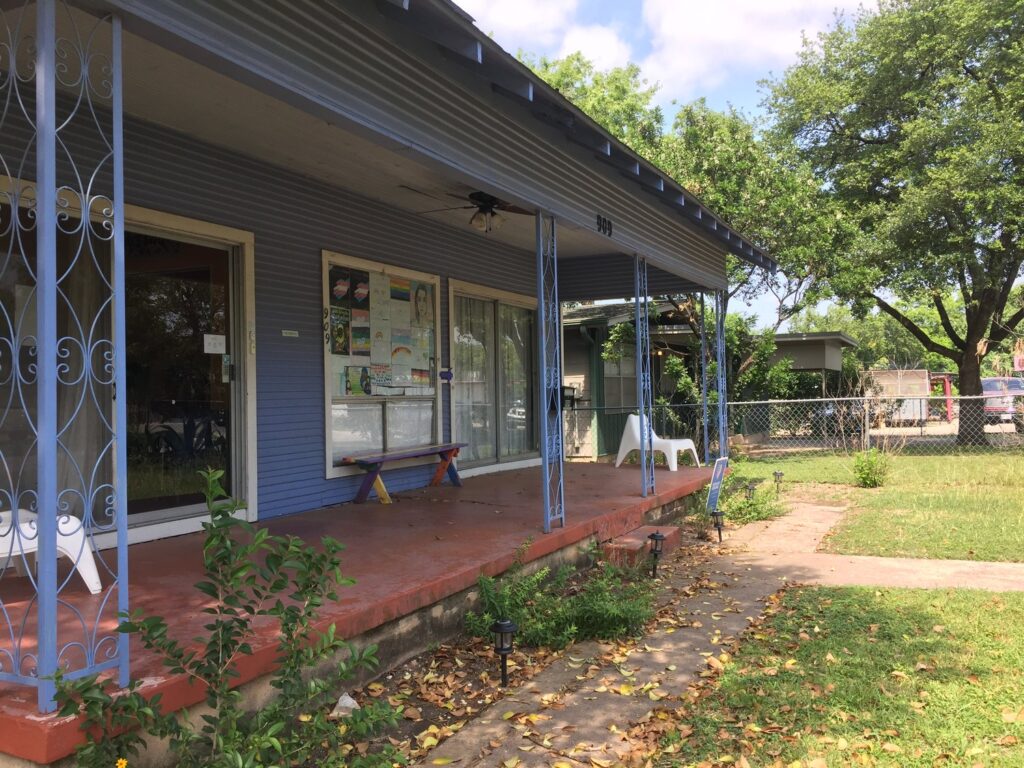by Lori W.

In Fall 2019, I interned at the most inviting little blue house you’ll find on 49th 1/2 St. With a spacious backyard and walls covered in homemade artwork, Out Youth is a sanctuary for LGBTQ+ identifying folks. As they say on their website, Out Youth is “home sweet home.” Upon entering the sliding glass doors, I was welcomed by friendly staff, pamphlets, and a fish bowl filled with fantastic button pins sporting the trans flag colors and a variety of pronouns (mine are she/her/hers). Out Youth has served thousands of folks since its establishment by two University of Texas social work graduate students in 1990. Had I known about Out Youth in high school, I definitely would have hung out at the Drop-In Center available on Sunday and Wednesday evenings. Out Youth also provides family support and counseling (the $10 fee can be waived for financial need).
I worked with the Texas GSA Network at Out Youth in response to a dire need, not only in Texas, but nationwide, for increased school support for LGBTQ+ students. The Gay-Straight Alliance, or GSA, is a student-run organization that fosters community between LGBTQ+ students and their allies. Nationwide, 37% of high schools, 17% of middle schools, and 5% of elementary schools had established GSAs in 2014. Only three states have a Gay-Straight Alliance in over half of their high schools: Massachusetts (60.5%), Connecticut (52.1%), and New York (50.7%). Among the least supported states are North Dakota (14.4%), Arkansas (13.9%), and South Dakota (just 9.3%). Although Texas is not among the states with the very smallest percentage of GSAs in high schools, it does not fare well (23.1%). Schools with GSAs experience less bigotry compared to schools without GSAs, including less bullying related to sexual orientation and gender identity. The presence of GSAs benefits both LGBTQ+ and heterosexual students. According to the PFLAG Stories and Numbers project, students at these schools feel more connected to the school community, have lower rates of alcohol and substance misuse, and experience better overall mental wellbeing. The work of GSAs can range from raising awareness for important days in the LGBTQ+ community (Day of Remembrance, National Coming Out Day) to educating members on relevant issues at meetings.
When I was in high school, it was affirming to have a faculty mentor, our school social worker, publicly support LGBTQ+ students at my school. The GSA Network is committed to empowering and connecting schools with existing GSAs in their state, as well as providing schools without GSAs with resources to start a chapter on their campus. The Texas GSA Network provides an online statewide forum, resources, and virtual trainings to GSAs. At my high school in Texas, teachers placed rainbow “Safe Space” stickers provided by the GSA club outside their classroom door. A few of my friends were GSA officers, and I felt like a lost lamb finding my way home when I followed them to meetings, where I learned about identities within the LGBTQ+ community that I was shielded from growing up. I felt far more comfortable at the GSA prom than my senior prom, and I attribute my high school’s accepting environment to becoming more open and comfortable with my sexuality in college.
My primary goals at Out Youth were to contact unregistered schools, to offer support in registering with the GSA Network, and to collect data from schools with GSAs on their activity, goals, and suggestions for improvement. I took notes on each call for a variety of factors, including faculty contacts, information on existing GSAs, and the tone of the call, that is, how the people I called reacted to learning about the GSA Network. The call tone was usually neutral or friendly, though occasionally hostile. The majority of the 300 or so schools I contacted during my internship refused our offer to help them set up a GSA, or let my call go to voicemail and then never responded. The low rate of response I observed speaks to a lack of faculty support and anti-LGBTQ fears and prejudices. When I could get someone on the phone, some reasons I heard for why a school did not have a GSA were: (1) Some schools, particularly college preparatory academies, did not offer extracurricular activities; (2) Schools that previously had an existing GSA were unable to replace their faculty mentor; and (3) School counselors, who were typically my first line of reference for contacting a school, were not knowledgeable enough about queer or ally faculty to recommend a mentor on the spot.
As I collected information on areas for improvement, I thought about my own suggestions. I remembered that Dr. Grayson Hunt mentioned at one of the intern meetings that, in his opinion, the name “Gay-Straight Alliance” should be updated. As society begins to acknowledge that both sexual identity and gender exist on a continuum, placing sexual identity into a binary of “gay” and “straight” seems inadequate for an organization that educates the public. Some schools refer to their organization as a Queer-Straight Alliance. I agree that such a key organization for queer youth should have a name inclusive of all sexual identities, as well as trans* and non-binary students. That said, I remain grateful that the GSA Network works hard to combat isolation among queer youth and support them at a pivotal point in their journey.
